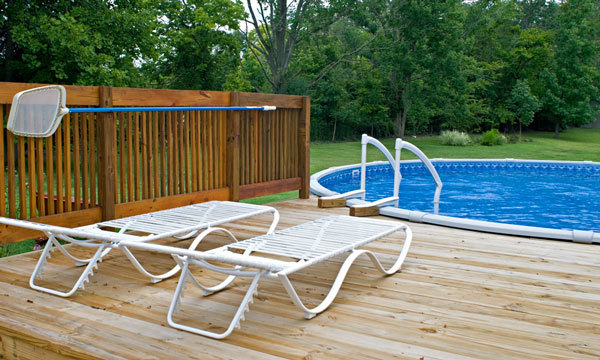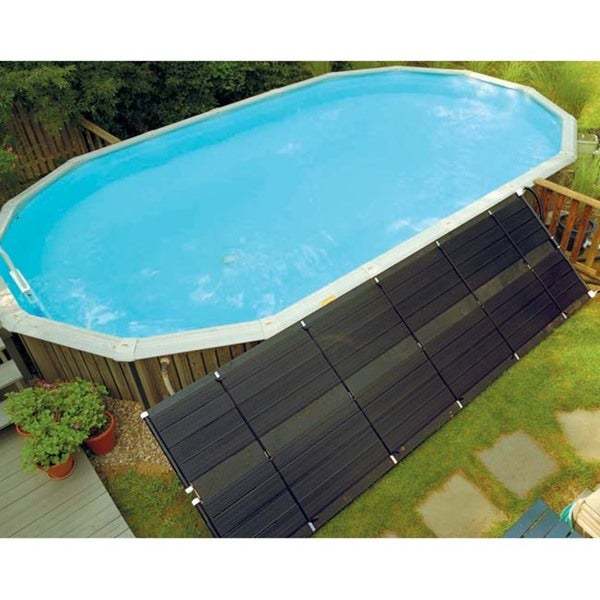Above Ground Pool vs Inground Pool: An Overall Comparison
by Hari Won
If you are thinking of installing a new swimming pool in your home, there are two options open for you: either you buy and install an above ground pool in your backyard, or you construct an inground one.
Both are very popular options in homes, restaurants, hotels, motels and commercial spaces around the world, and they are very different options from each other.
Contents
When it comes to a choice between an above ground swimming pool and an inground swimming pool, there are a lot of factors you need to consider. There is of course, a difference in price between installing an inground swimming pool and an above ground one, but there are many more differences when it comes to the environment, material you can use, the structure of your home, location, weather and space.
There are a lot of pros and cons to go through before deciding on the type of swimming pool you want in your home, and you can find them all here, in this article.
Difference Between Above Ground and Inground Pool

Difference in Costs
Above Ground Swimming Pools: On an average, installing an above ground pool can take up from $900 to $3000, depending on the size, height, material and shape. If you have professional proficiency, you can actually purchase a DIY above ground pool kit and install the whole thing yourself, or call in local professional help.
The more expensive the above ground swimming pools, the more durable and thicker materials they are made from, and has upgraded filtration systems, better quality safety ladders and pool cleaning technologies. The least expensive ones, costing only a few hundred dollars, are merely similar to an inflatable kiddie pool.
In ground Swimming Pools: Installing an inground swimming pool can take anything from $5000 to $45,000, depending on the shape and size, and what kind of builders you are using. Some of the most spaciou, luxurious and high-quality swimming pools that you see in hotels and resorts can actually cost around $80,000, but they are suited for regular use by a large number of people, for many years.
The cost will also vary depending on whether you are hiring a local construction company to use the materials that came in a DIY swimming pool kit, or if you are giving them the contract of installing the pool themselves, using their own materials, labor and expertise.
Difference in Time of Installation
Above Ground Swimming Pools: Unless you need to extensively clear your land of bushes, debris and dirt, or if you need to level your land, installing an above ground swimming pool takes about a day. Two days, if the pool is an exceedingly large one.
Inground Swimming Pools: Inground swimming pools take any amount of time between 6 to 8 weeks to complete. This includes everything from digging, clearing the land and building the pool itself. If the weather is bad or if it’s the rainy season, it might take another week or so for the construction to finish.
On the other hand, if your swimming pool is made of vinyl fiber or fibreglass, it might take less than 6 weeks to finish.
Difference in Material Used
Above Ground Swimming Pools: Since these swimming pools are usually built from store-bought kits, the different parts are made of different materials. An aluminum swimming pool is the most popular and the most durable one, as well as a resin pool which is also very popular.
Iron or steel can also be used for swimming pool walls, but they rust and deteriorate very quickly. Aluminum might also oxidize over time, but it takes many years to do so; if you get thick aluminum walls for your above ground swimming pool, it will last a number of decades.
Inground Swimming Pools: These kinds of swimming pools are traditionally built of concrete, but these days, fiberglass or vinyl pools are becoming popular as well. For a moe decorative look, colorful tiles are placed at the bottom, over the concrete floor, usually blue in color. Gunite is another material used in swimming pools, and is quite popular if you want your pool to have a creative shape.
Difference in Shapes
Above Ground Swimming Pools: These above ground swimming pools are usually round or oval, and there’s not much variety in the shape.
Inground Swimming Pools: You can make almost any shapes with your inground swimming pools, but only when you are using concrete or gunite. Pools with vinyl liners are usually rectangle, as they are built from store-bought materials. It’s the same with fiberglass pools, but there are a few options to choose from.
If you want a creative and curvy shape for your swimming pool, it is best to use concrete or gunite for the construction. However, rectangular swimming pools are more convenient, as automatic pool covers are only available in rectangle shape.
There are a lot of differences between inground and above-ground swimming pools, based on everything from materials used, shapes, convenience, time taken to install and cost. However, both kinds of pools have their pros and cons, which we are going to discuss here.
Above Ground Swimming Pools: Pros and Cons

Pros:
Above ground swimming pools are temporary swimming pools, so you can install them anywhere, even in houses that you are renting and don’t own. With some models, you can even dismantle the parts to install in another house when you move to a new address.
These pools are also easy to maintain. They don’t require regular cleaning, filtering, bleaching or refilling. If your above ground pool is a small one, you can simply use a rubber sheet to cover it.
The water inside these pools never remain stagnant, which means that you don’t have to treat the water regularly. If it is standing in your backyard, you can simply let out the water and refill it after a decent interval, and the ground will soak up the water.
You can install your above ground anywhere, and even change the location within a small space. If your swimming pool gets direct sunlight in the summer and the water becomes too hot, you can move the pool under the shade of a tree, and vice versa.
Setting up these swimming pools are easy and takes less than a day. With the correct technical knowledge, you can install the pool yourself.
Above ground swimming pools costs significantly less compared to inground pools.
Cons:
Above ground swimming pools add zero value to your property. If you have plans to rent out or sell your house in the future, you need to install an inground swimming pool to add value to your property.
If you are installing the pool in your backyard, it will damage the grass growing underneath. After you have dismantled or moved the pool away to another location, you have to plant new grass where your pool stood before, or wait a long time before the grass grows back naturally.
While inground pools are permanent and will last very long, these kind of swimming pools damages more frequently and easily. Besides, they don’t really last very long and may require replacement after a few years with heavy use.
With these pools, you don’t get a lot of options for added features, decorations or space for lounging around. There are also limitations in case of size, shape and depth of an above ground swimming pool.
Inground Swimming Pools: Pros and Cons
Pros:
With inground swimming pools, you can design it in any way - with any shape, size and depth. You can choose the classic rectangular shape, an oval or even curved, make it a small one or cover your entire backyard.
You can even add different depths in the same swimming pool, a low-depth corner or side for children and another for adults, with or without a safety barricade in between. This makes it safer for your family if you have children and they like to swim.
Inground swimming pools can increase your property value manifold. The more you spend in installing the pool and the more luxurious it is, the more your home’s value will increase, both for selling and for renting.
Also Read: 10 Must Have Tools For Homeowners
With an inground swimming pool, you can add any decorative feature or enhancement to your pool area. You can turn your poolside backyard into a spa or a garden, and it will only enhance the beauty of your home and increase its value.
These kind of swimming pool doesn’t get damaged much. You might have to regularly filter the water and get the pool cleaned, but there won’t be any damage to the construction. Installing an inground swimming pool means that you and your family will be able to use it regularly, and for decades to come.
Cons:
Constructing an inground swimming pool is a few times more expensive than an above-ground pool. This is because it is a permanent fixture in your home and requires much more work to construct, starting from clearing the space, digging, constructing, etc.
These inground pools also take a lot of time to construct. The entire process can take any time from 6 to 8 weeks, more if the pool happens to be a large one or the weather is bad.
Your expenses doesn’t just stop at building the swimming pool; there are further expenses in installing a water filtration system, an automatic/manual pool cover, accessories and maintenance. These pools need to be regularly checked and maintained by a professional, and sometimes even cleaned by a professional.
If there should be any problem in the pool, either in the filtration system or to the construction, repairs are going to be extremely expensive.
Inground swimming pools are forever, at least - a few decades. If you want to close up the pool and fill it up, or transform it into land to build on or a garden, the construction costs are going to be extensive and expensive. Anyone who wants to construct an inground swimming pool on their property should be extremely sure about the whole thing.
There’s a lot of advantages to having your personal, very own pool, in the privacy of your own backyard. You have your very own permanent exercise equipment, your very own haven to relax and spend quality time with your family, and a great place to host parties and swim on your weekends.
However, between an inground and an above-ground swimming pool, there are too many factors that you need to consider. Above ground swimming pools are the more practical, less expensive choice.
If you have a limited budget and only plan to use the pool a few times in a week, or if you are renting, these pools are the perfect choice for you.
These above ground pools can be a great source of entertainment for your whole family, both if you use them regularly or on the weekends. There might not be many options for design, but you can still choose a shape, height and size that fits your backyard.
On the other hand, if budget is not a factor and you want to increase the value of your property, of course an inground swimming pool is the perfect choice for your home.
It will be a permanent fixture in your house and worth decades of entertainment and enjoyment for your family, although the costs of maintenance might be high, and you’ll have a lot of trouble transforming the pool back to something else if you no longer want a swimming pool in your backyard.
The choice is simple, actually, if you consider all these factors.

About Hari Won
Hari has been a close friend with Josh since kindergarten. Her place is right around the corner from Josh’s.
She claims they are only friends. Hari also loves to drink. By accident, she tried her first taste of beer in middle school; felt in love with them since then.
Life has been up and down lately for Hari. She and/or other friends often meet up with Josh for a few packs. They may drink through the night, while taking turn to tell their life stories.
Hari received her BS degree in biochemistry from University of Phoenix. She hoped to become a great brewmaster someday...
Thoughts on "Above Ground Pool vs Inground Pool: An Overall Comparison"
 |
 |
 |
 |
Kitchen - Outdoor